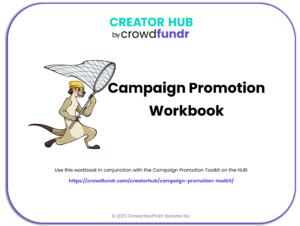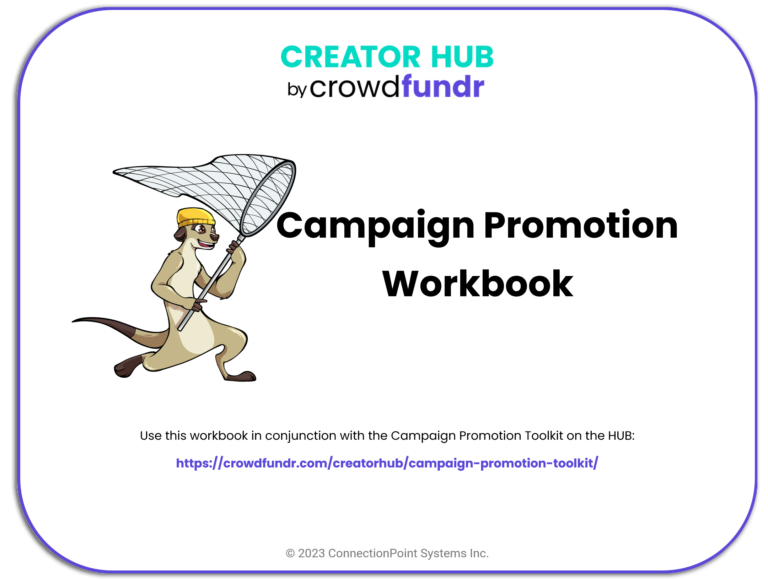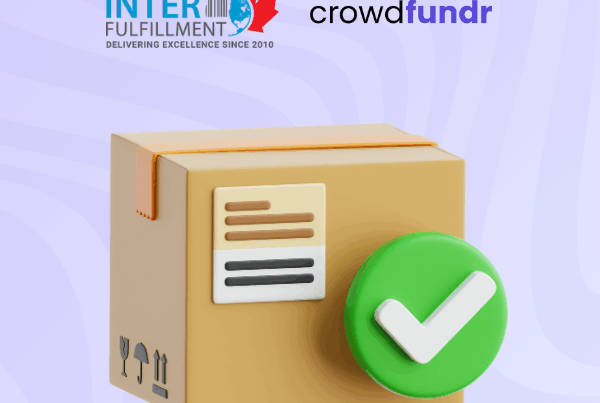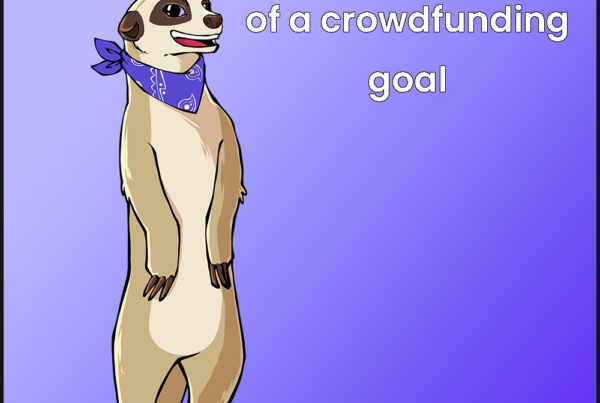Crowdfunding campaign promotion is the next crucial step to success – you can create the perfect campaign for your creative project, but it won’t matter if there’s no one to see it! With this toolkit, we’ll guide you through the ‘3 Bs’ of attaining a crowd – building, buying, and borrowing – and how to use the available tools to put your project in front of those who’ll love it most.

In this crowdfunding promotion toolkit, we’ll discuss:
- Defining your crowd
- Promotional timeline
- Captivate through storytelling
- Determining your top-tier crowd
- Building a crowd
- Buying a crowd
- Borrowing a crowd
Defining your crowd

This section appears in a couple of our toolkits around campaign goals and strategies. And for good reason – while you might not have created this project with a specific audience in mind, some will love it more than others. Practically every part of your crowdfunding campaign is designed around speaking to these supporters, which is why we emphasize knowing who they are.
If you’ve completed this activity already, skip to the next part. If not, consider this table:
| WHO is my crowd? | Every project has a target audience. Is it a specific demographic? Type of fan? Someone who likes a specific genre, or has a certain kind of humor? | C |
| WHAT can I discuss with my crowd? | This is the value you bring. Is it insight into your project(s) theme? Teasers? Samples? Do they understand what makes you and your creation(s) unique? | |
| WHERE is my crowd? | You can find your people in multiple places online: social media and their targeted groups, blogs, forums, and, ideally, your own website and social followers. | |
| HOW can I engage my crowd? | Email, newsletters, forum chats, social media posts, blog comments, etc. | |
| WHEN can I bring my project to my crowd? | You should spend anywhere from 3-6 months building this crowd, depending on how fresh you’re starting. |
Crowdfunding Promotion Timeline

Have you read our article on the dual paths of pre-launch promotion? Much of the work over the first part of this toolkit revolves around this pre-launch concept, so if you have not read that article, do that now. We’ll wait.
You’ll notice from that article that the timeline begins 90 days before launch. And you might be balking right now because you didn’t anticipate thinking that far ahead.
Think about movie promotion – long before a movie is released, we see announcements about release dates, casting, filming locations, and teaser trailers. Then, with a few weeks to go, we’ll see much-anticipated full-length trailers and reviews from critics. Even the latest iteration of Batman would have flopped opening weekend if no one had known it was coming.
How long you ramp up depends on how established your online presence is. Well-established creators with a loyal following of supporters might not need long at all – they may even be able to launch a small campaign with no notice and still achieve funding. Newer creators will want to consider a ramp-up period from 3 to 6 months.
Here’s the main image from that article:
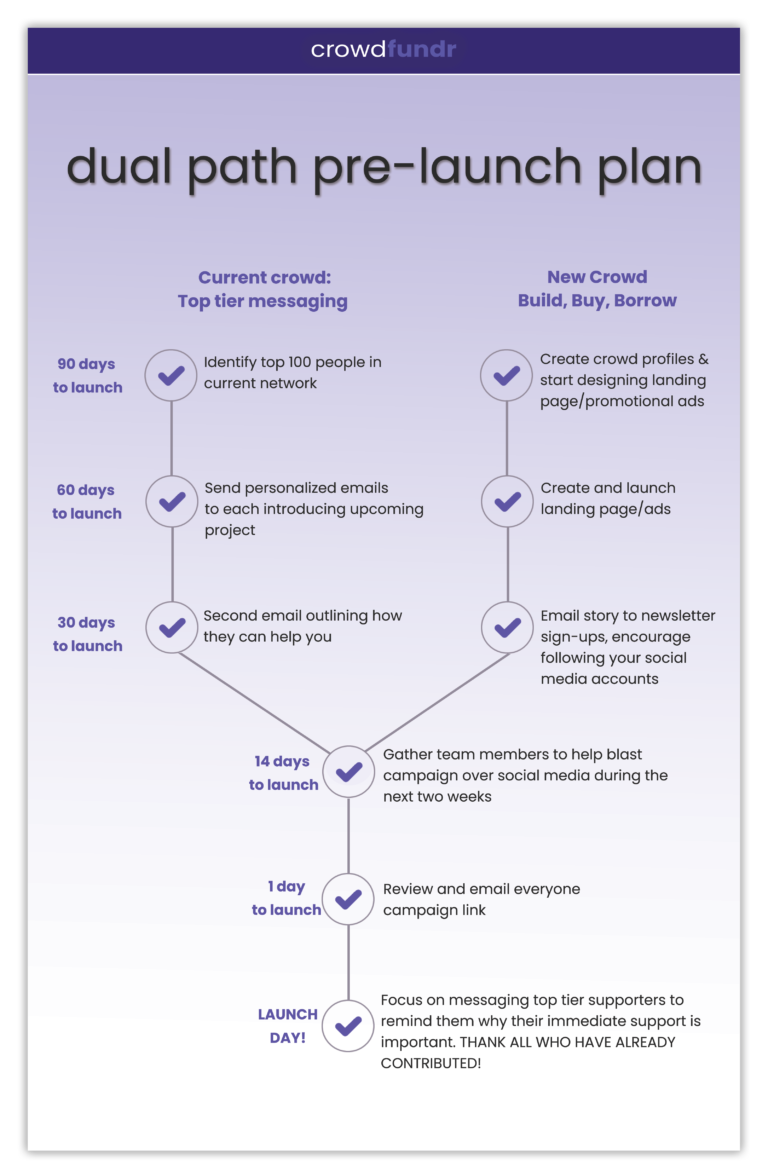
So, it will take some time and planning to get the crowd needed for your project, and a timeline helps you stay on track.
Here’s a sample timeline:
| Promotion | Release Date | Where will it be posted? |
| Personalized announcement of upcoming campaign to top tier. | July 1 | Email to loyal supporters. Post on our socials |
| Launch landing page | July 1 | Our website |
| Release paid ads | July 1 | Google, Facebook, TikTok |
| Second personalized emails to top-tier crowd | August 1 | Mailchimp |
| First campaign newsletter | August 1 | Mailchimp |
| First social media posts about the campaign | August 15 | FB, X, IG, TTK |
| Day-before launch email | August 31 | Top tier and newsletter/campaign subscribers |
| Campaign launch date | September 1 | EVERYWHERE! |
Plan your promotional timeline in the workbook below. *If easier, read the rest of this toolkit to understand the points to include, but the point here is to ensure you keep key dates front and centre (maybe print it out and tape it to your forehead!) so you keep on track for your launch date.
Crowdfunding Promotion Through Capitative Storytelling

Before we delve into the specifics of this toolkit, let’s pause and revisit your campaign. Because crowdfunding success centers around sharing, your story is essential to your arsenal. We design our storytelling guidelines to captivate and engage your current supporters and entice them to share.
There will always be new supporters to bring in, and what better way than to use those who have already contributed? That way, you aren’t only marketing to your community but your community’s community as well.
But sharing once won’t cut it. A typical marketing principle is the rule of seven, which states that a potential customer (supporter) needs to interact with a brand at least seven times before they’ll recognize and engage with it.
And you cannot just share the same thing over and over again. You need new content to resonate with this new crowd, so that updates will be invaluable for your campaign.
This article explains all about updates and what you can include. While not all updates can be planned, of course, some can (you can even schedule them ahead of time!). There’s background information about you as a creator, your project and its design or production, teaser images, samples, and anything new and valuable.
Encourage your supporters to share these updates along with your campaign for some effective crowd-to-crowd advertisements.
Determining Your Top-Tier Crowd For Crowdfunding Promotion

If an intrigued but new-to-you supporter lands on your campaign and it’s sitting there with no funds, they are not likely to contribute. Humans are social animals, and the concept of ‘social proof’ is imperative with crowdfunding. This is the idea that the more people are involved in something, the greater the likelihood of others joining.
That means it’s tough to get over the hurdle of the first contribution. But do you know who is likely to contribute to this campaign? Someone who knows and loves you and your work.
You’ll single out this list and personally email each of them, letting them know this campaign is coming and you’ve identified them as someone likely to contribute. While we don’t recommend that emails be long, personalizing them takes time, so stick to 100 as a max (but you do NOT need that many if you’re having trouble identifying them.
In your workbook below, write down the names of those most likely to contribute to your campaign. If all you can think of now is your uncle and his book club, that’s ok! You have to start somewhere. But do not fill this list for the sake of filling it – you don’t need the extra work if you genuinely don’t feel someone’s likely to contribute.
Building A Crowd For Crowdfunding Promotion

Time to dive into the first step in growing your crowd with your pre-launch if that’s something you’ve determined you need from our Campaign Goal toolkit.
- Newsletter/Email lists
- Landing page
It works like this:
Someone sees an ad or hears about you or your project from a friend, media event you participated in, your socials, etc. à they’re taken to your landing page, where they learn more about your project à they think, “Dang, I want this!” and enter their email à you send newsletters with special offers and announcements on when the campaign launches.
So, let’s learn how to build newsletters and a landing page!
Newsletter
Email lists will be your bread and butter for campaign promotion. However – and this is the most critical piece of advice in this toolkit – your newsletter email list MUST BE HIGH QUALITY! This means the email addresses must be accurate and deliverable.
For example, Crowdfundr will send notification emails to our users and their supporters from ‘no-reply@crowdfundr.com.’ Emails sent to addresses like these are bounced back as undeliverable. If you send out an email with multiple bounce-backs or unsuspecting recipients that report you as spam, your sender IP reputation will be in jeopardy. Avoid that by ensuring the email addresses you send to are genuine and knowingly enrolled.
Other important features of a newsletter:
- Includes an ‘unsubscribe’ option
- Columns between 500-680 pixels wide
- One core message and call-to-action (for example: Check out your exclusive pre-launch access to our Crowdfundr campaign!)
- Subject line between 46-70 characters
- Small file size (check your picture and video size)
- Sender address is a custom domain name linked to your website
- Avoid ‘spammy’ words such as ‘free,’ ‘offer,’ etc.
Landing Page
A landing page is a specific website with a goal to convert visitors into leads. They have one call-to-action (CTA) – in this crowdfunding scenario, that CTA is to enter their email.
Why is this effective?
Email lists are the highest-converting crowdfunding campaign supporters because you’ve already grabbed their attention once. These supporters have clicked on a post or ad to get to this landing page and were interested enough to input their email into a form you’ve set up. If you take the time to craft a good landing page and spread it everywhere you can, you’ll gain a solid email list to skyrocket support on launch day.
Here’s a demo landing page for a comic about our feisty Meerkat clan:

What goes on a landing page?
You want your landing page visitors to immediately know what they’re looking at and what you want them to do.
Position a captivating visual element, a concise yet compelling description of your value proposition, and a visible email submission area at the top of the page. This critical content should be placed “above the fold,” ensuring it is visible without scrolling:
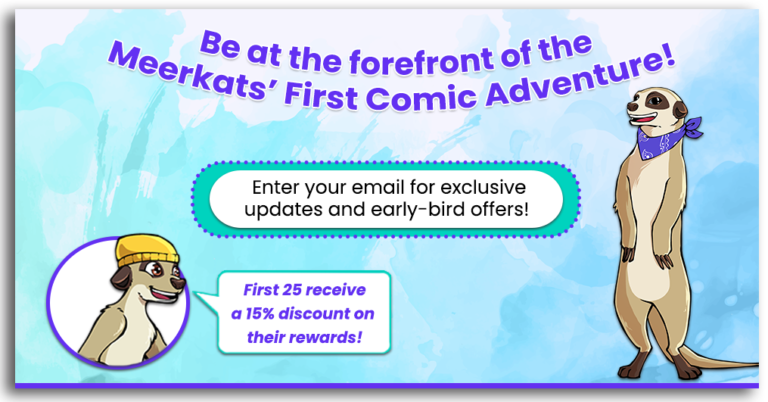
Background images or colours and/or a coloured bar separates this fold.
If a visitor wants more information about your project before subscribing, include it ‘after the fold’ in short sections. Our example is a simple one, but other information you can include are:
- About you and your collaborators (if applicable)
- Teasers or samples of the project
- Videos and images
- Identify who would love your project
- Information about the upcoming campaign
- Timeline of what’ll happen once the visitor subscribes
- Reviews, accolades, awards, etc. (for this project or another you’ve done)
This list is not exhaustive; feel free to include anything you feel is essential for visitors to know. Just make sure you keep the information short. We don’t want our visitors to have to read too much.
Put another call to action at the bottom of the page for those visitors who chose to look at the whole thing. If your landing page feels long, insert a CTA in the middle. We want to remove any barriers to someone providing their email, and a barrier can be as simple as scrolling and then forgetting what you were asking for.
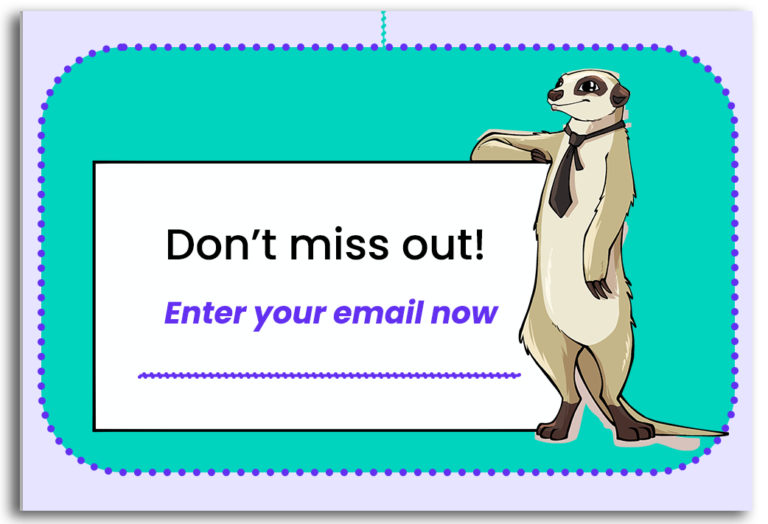
How and where are landing pages built?
Depending on your available resources, you have some options to explore:
- Integrate it into your own website or a partner site.
- Use email management software such as Mailchimp or Constant Contact. Many of these platforms have free versions if you expect a smaller audience.
- Use Crowdfundr’s platform features. Your campaign is a live website; it is just not searchable (either by internet browsers or our Crowdfundr Find page), and no one can contribute until it is launched. Keen visitors can ‘Subscribe’ to the campaign and receive an email notification when it launches.
This does reveal your campaign early (which might not be finished yet), but you can add pre-launch messaging to the campaign to delete later (stories are editable until a campaign finishes!).
Where do people find the landing page?
From your ads and posts! Of course, you have your own social media accounts and possibly existing email lists, but in the following sections, we’ll talk about how to “buy” and “borrow” crowds to advertise your pre-launch plan and live campaign.
Buying A Crowd For Crowdfunding Promotion

Time to talk ads!
Buying a crowd involves paid advertisement. It does NOT mean paid marketing lists. Please do not consider buying an email list because:
- They won’t be effective anyway. Even if someone does open the email, they’ll either be upset at the unsolicited ad or assume it’s a scam;
- You hurt your email sender’s reputation, and even your legitimate supporters might not receive anything;
- It’s against our Terms of Service.
You’ll want to explore paid advertising for your pre-launch and live campaign marketing plans (the costs of which you can include in your goal). Before launch, your ads will direct people to whatever you use as the landing page to collect emails.
This is also where analytics come in handy: using a service or free versions of analytical software (such as Google Analytics or Meta Pixel), you can determine what site or platform most people clicked on your campaign from, and – if you run more than one ad option – which ad brought more people who contributed.
Ads must be short and immediately interesting – think about how long you spend looking at ads. Use the characteristics from our activity on defining your crowd to choose the best media and key messaging to grab their attention.
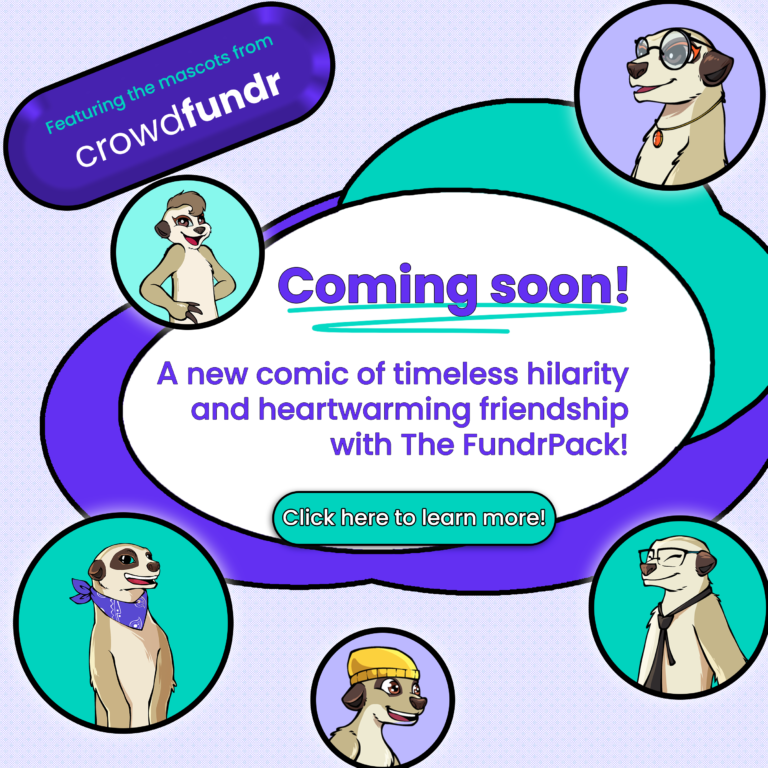
Elements to consider for your ad are:
- Keywords that align with what your target audience is likely to search for;
- A compelling headline that’s concise, relevant, and encourages people to learn more;
- Engaging ad copy to communicate the value proposition and unique selling points of your product, with language to resonate with your target audience;
- Call to action – such as ‘Learn More,’ ‘View Now,’ ‘Check It Out,’ etc.
- Give them something – people love stuff! A great boost to the amount of signups you receive is some sort of incentive. It could be a discount on your campaign rewards, a free download (art, ebooks, etc.), access to exclusive content, etc.
From your work on crowd profiling, choose which media would be your best option for ads (for example, Facebook, Twitter, Google, etc.). These ads work on a ‘pay-per-click’ model, where you choose a maximum budget you’re willing to pay for the ad and are only charged when someone clicks it. The platform will pull the ad when you’ve reached that maximum amount (unless you extend it).
Borrowing A Crowd For Crowdfunding Promotion

The last option for growing your crowd is to borrow it from someone else, and your options here are as broad as your creativity.
The easiest crowd to borrow is from your current supporters sharing your campaign. This is the essence of crowdfunding: you and your team share the campaign and ensure part of your story involves asking supporters to share with their crowds.
Outside of that, we’re looking for influencers in whatever community(ies) you’ve identified in your crowd profiling. For example,
- Social media groups or influencers with a large audience in your niche;
- Local news outlets (radio, tv)
- Podcasts to guest-host
- Associations/Nonprofits/etc
- Blogs
- Offline networking at conferences, conventions, etc.
A press kit will be helpful if you’re targeting online or local media outlets. See this article for what to include.
Crowdfunding Campaign Promotion Workbook
We’re here to help!
Our Discord channel is a place to connect with other creators and the Crowdfundr team to ask questions, seek advice, and share strategies. But if you don’t do Discord, or want to schedule a demo, feel free to email us at support@crowdfundr.com.


